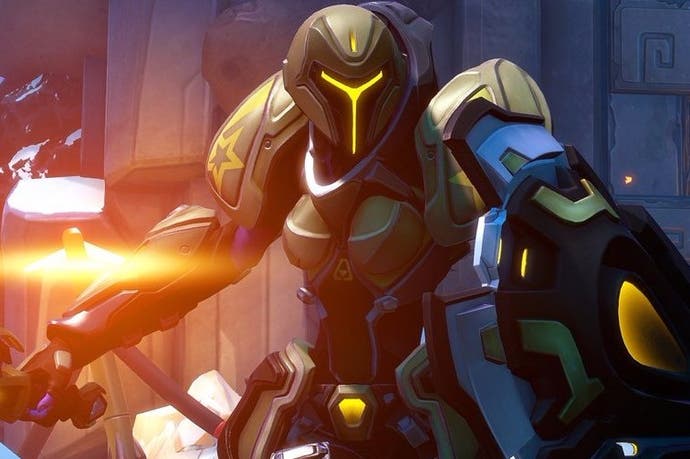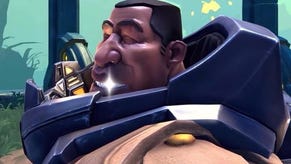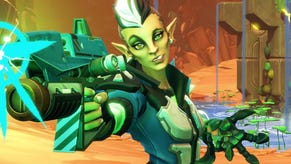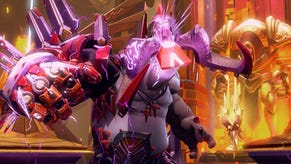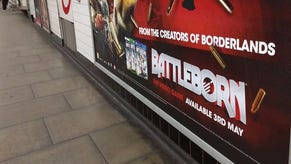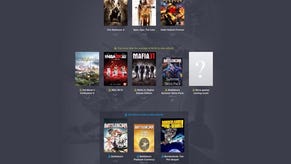Performance Analysis: Battleborn beta on PS4 and Xbox One
Beyond Borderlands: Digital Foundry assesses Gearbox's latest console work.
The MOBA craze has transitioned to first person shooters, with two titles throwing up open beta tests within weeks of each other. Blizzard's Overwatch put in a solid 60fps appearance, but Battleborn takes a slightly different approach. Borderlands developer Gearbox caps performance at 30fps, with obvious implications for the gameplay in a high-speed shooter where controls need to be sharp and precise. As expected, the experience doesn't feel quite as tight as Blizzard's offering, but Battleborn has charms of its own.
The beta offered up two modes of play with a brace stages in each. Story mode sees players work together to bring down waves of enemies before taking on larger bosses in traditional FPS fashion, while the PvP multiplayer sees users working in terms against each other, with MOBA and tower defense elements woven into the action. Robot minions are escorted across the map while battling opponents, skills are unlocked, and everyone uses different characters. This is presented with a comic book art style, and humour reminiscent of the Borderlands games, while the shooting features a similar level of weightiness.
Once again Gearbox Software rolls out its modified Unreal Engine 3, building upon the core technology that powers Borderlands 2 and The Pre-Sequel, with hand-drawn textures that give the game an almost cel-shaded appearance, albeit with a slightly more realistic edge. Surface shaders are more authentic compared to those in Borderlands, resulting in materials such as metals, snow, and stone appearing a little more natural. The lighting model also provides depth to the comic book style visuals, while shadow quality is smooth and free from obvious stairstep artefacts.
All of these elements are replicated to an equal standard across both consoles, along with the core effects work, consisting of motion blur, depth of field, reflections, and alpha transparency for smoke and fire. Both consoles also deliver a native 1080p presentation with post process anti-aliasing. Image quality remains crisp and texture details are fairly well defined, but there are some noticeable jaggies and pixel popping across long edges and distance geometry - a common side-effect of using a cheaper post process AA algorithm.
On first impressions, Battleborn appears to straddle the line between last and current-gen visuals, with the bulk of the upgrades coming in the form of increased geometry, with lighting and effects getting a less dramatic transformation. In particular, texture and normal map quality is rather variable with some surfaces featuring low resolution assets, which appear blocky up close. It's not something one would expect from a current-gen release, and certainly gets in the way of providing a full-on generation leap over Borderlands 2. Here, the jump in graphical quality is more conservative, especially seeing as Gearbox are targeting 30fps rather than higher frame-rates.
Indeed, the decision to target 30fps seems like a strange choice given that most competitive shooters on PS4 and Xbox One aim for 60fps, as that frame-rate allows for more precise controls and the best level of feedback between the player and the game. However, shootouts in Battleborn are littered with explosions and copious amounts of alpha effects as standard, and this creates a near constant barrage of action that makes blasting AI controlled robots and human opponents rather exciting. These are bandwidth-heavy scenes, and perhaps achieving a 60fps update was simply off the cards in these situations. As such at a 30fps cap becomes a logical choice, and Battleborn delivers a mostly solid level of performance at that frame-rate.
The story mode provides some great stress tests to tax the engine. Halfway through the The Void's Edge mission, the landscape opens up and we're greeted with long draw distances combined with dozens of enemies and lots of effects work once the shooting kicks off. But despite this, the game holds close to the 30fps target with ease, and gameplay remains mostly consistent. Here an adaptive v-sync is in play, producing some mild tearing, but this also helps to prevent frame-rates from getting more heavily impacted. As a result, the controls feel mostly unaffected by the occasional 1-2fps dips that occur when the engine is under load, and aside from slight momentary judder, the experience appears smooth in motion.

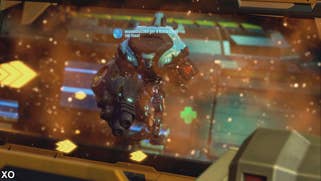
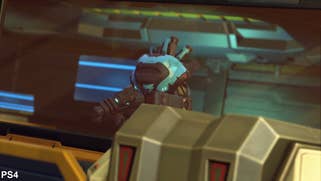



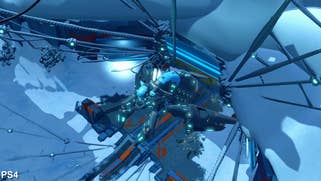



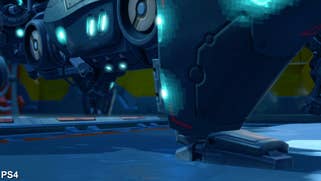
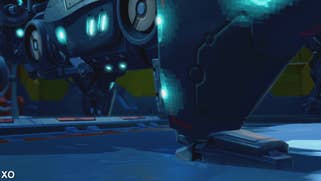

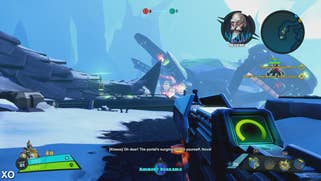
Across the general run of play, both consoles deliver a similar experience too, with firefights and alpha-heavy scenes mostly passing by without a hitch. However, in some circumstances the PS4 version takes the lead. Kicking off The Void's End, frame-rates drop down to 24fps on Xbox One as we traverse around the mountain side, while performance remains stable on Sony's system. This is something of an outlier though, and the game maintains its 30fps target when it matters the most.
The same level of stability is also present in the PvP multiplayer modes, where the occasional dropped or torn frame is all that stops the game from hitting a locked 30fps across the duration of a match. Gameplay is just as fast and intense as the story mode, and there's little to separate the experience from a technical point of view.
So it's a solid showing from Battleborn on both consoles at this point, with performance throwing up no real cause for concern. That said, the decision to target 30fps for a hectic multiplayer shooter feels like a missed opportunity. Running at 60fps provides superior controller response and smoother lateral motion, both elements which help to craft a more polished experience. And this is one area where Overwatch has the advantage, delivering a similarly colourful taste at a MOBA gameplay within a shooter, but operating at a frame-rate better suited to the task at hand. If you're looking for 60fps, PC becomes the default choice.
Even so, Battleborn comes across as a reasonably entertaining, if initially unremarkable entry in the genre. At this point it remains to be seen if the game will carve out a dedicated fanbase like Gearbox's well-regarded Borderlands series, but from a technical perspective the beta has established that there are no major issues to address ahead of launch.
